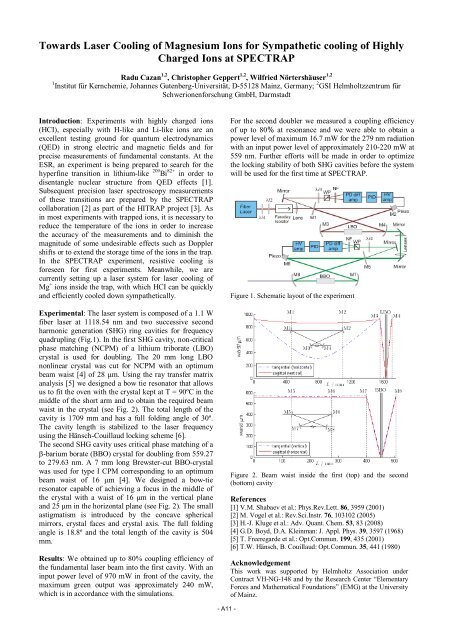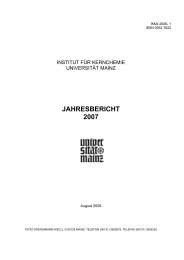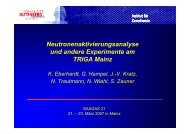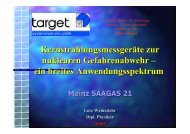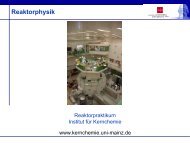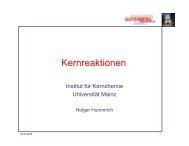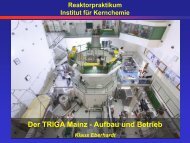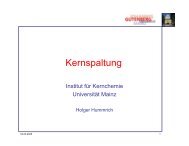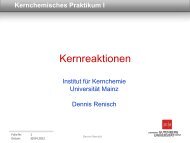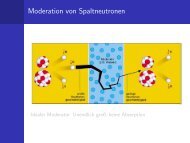institut für kernchemie universität mainz jahresbericht 2009
institut für kernchemie universität mainz jahresbericht 2009
institut für kernchemie universität mainz jahresbericht 2009
Create successful ePaper yourself
Turn your PDF publications into a flip-book with our unique Google optimized e-Paper software.
Towards Laser Cooling of Magnesium Ions for Sympathetic cooling of Highly<br />
Charged Ions at SPECTRAP<br />
Radu Cazan 1,2 , Christopher Geppert 1,2 , Wilfried Nörtershäuser 1,2<br />
1 Institut <strong>für</strong> Kernchemie, Johannes Gutenberg-Universität, D-55128 Mainz, Germany; 2 GSI Helmholtzzentrum <strong>für</strong><br />
Schwerionenforschung GmbH, Darmstadt<br />
Introduction: Experiments with highly charged ions<br />
(HCI), especially with H-like and Li-like ions are an<br />
excellent testing ground for quantum electrodynamics<br />
(QED) in strong electric and magnetic fields and for<br />
precise measurements of fundamental constants. At the<br />
ESR, an experiment is being prepared to search for the<br />
hyperfine transition in lithium-like 209 Bi 82+ in order to<br />
disentangle nuclear structure from QED effects [1].<br />
Subsequent precision laser spectroscopy measurements<br />
of these transitions are prepared by the SPECTRAP<br />
collaboration [2] as part of the HITRAP project [3]. As<br />
in most experiments with trapped ions, it is necessary to<br />
reduce the temperature of the ions in order to increase<br />
the accuracy of the measurements and to diminish the<br />
magnitude of some undesirable effects such as Doppler<br />
shifts or to extend the storage time of the ions in the trap.<br />
In the SPECTRAP experiment, resistive cooling is<br />
foreseen for first experiments. Meanwhile, we are<br />
currently setting up a laser system for laser cooling of<br />
Mg + ions inside the trap, with which HCI can be quickly<br />
and efficiently cooled down sympathetically.<br />
Experimental: The laser system is composed of a 1.1 W<br />
fiber laser at 1118.54 nm and two successive second<br />
harmonic generation (SHG) ring cavities for frequency<br />
quadrupling (Fig.1). In the first SHG cavity, non-critical<br />
phase matching (NCPM) of a lithium triborate (LBO)<br />
crystal is used for doubling. The 20 mm long LBO<br />
nonlinear crystal was cut for NCPM with an optimum<br />
beam waist [4] of 28 �m. Using the ray transfer matrix<br />
analysis [5] we designed a bow tie resonator that allows<br />
us to fit the oven with the crystal kept at T = 90ºC in the<br />
middle of the short arm and to obtain the required beam<br />
waist in the crystal (see Fig. 2). The total length of the<br />
cavity is 1709 mm and has a full folding angle of 30º.<br />
The cavity length is stabilized to the laser frequency<br />
using the Hänsch-Couillaud locking scheme [6].<br />
The second SHG cavity uses critical phase matching of a<br />
�-barium borate (BBO) crystal for doubling from 559.27<br />
to 279.63 nm. A 7 mm long Brewster-cut BBO-crystal<br />
was used for type I CPM corresponding to an optimum<br />
beam waist of 16 �m [4]. We designed a bow-tie<br />
resonator capable of achieving a focus in the middle of<br />
the crystal with a waist of 16 �m in the vertical plane<br />
and 25 �m in the horizontal plane (see Fig. 2). The small<br />
astigmatism is introduced by the concave spherical<br />
mirrors, crystal faces and crystal axis. The full folding<br />
angle is 18.8º and the total length of the cavity is 504<br />
mm.<br />
Results: We obtained up to 80% coupling efficiency of<br />
the fundamental laser beam into the first cavity. With an<br />
input power level of 970 mW in front of the cavity, the<br />
maximum green output was approximately 240 mW,<br />
which is in accordance with the simulations.<br />
For the second doubler we measured a coupling efficiency<br />
of up to 80% at resonance and we were able to obtain a<br />
power level of maximum 16.7 mW for the 279 nm radiation<br />
with an input power level of approximately 210-220 mW at<br />
559 nm. Further efforts will be made in order to optimize<br />
the locking stability of both SHG cavities before the system<br />
will be used for the first time at SPECTRAP.<br />
Figure 1. Schematic layout of the experiment<br />
Figure 2. Beam waist inside the first (top) and the second<br />
(bottom) cavity<br />
References<br />
[1] V.M. Shabaev et al.: Phys.Rev.Lett. 86, 3959 (2001)<br />
[2] M. Vogel et al.: Rev.Sci.Instr. 76, 103102 (2005)<br />
[3] H.-J. Kluge et al.: Adv. Quant. Chem. 53, 83 (2008)<br />
[4] G.D. Boyd, D.A. Kleinman: J. Appl. Phys. 39, 3597 (1968)<br />
[5] T. Freeregarde et al.: Opt.Commun. 199, 435 (2001)<br />
[6] T.W. Hänsch, B. Couillaud: Opt.Commun. 35, 441 (1980)<br />
Acknowledgement<br />
This work was supported by Helmholtz Association under<br />
Contract VH-NG-148 and by the Research Center “Elementary<br />
Forces and Mathematical Foundations” (EMG) at the University<br />
of Mainz.


